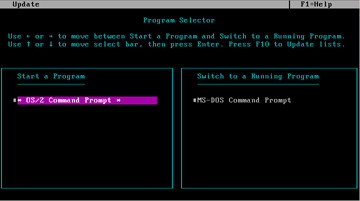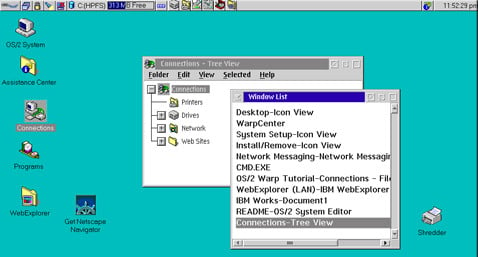Original URL: https://www.theregister.com/2012/11/27/the_os_wars_os2_25years_old/
OS/2 a quarter century on: Why IBM lost out and how Microsoft won
Let's pile into the DeLorean to see what might have been
Posted in Software, 27th November 2012 16:35 GMT
Twenty-five years ago IBM unveiled its master plan to reclaim the PC industry. In November of that year the first floppy diskettes of OS/2 version 1.0 trickled out. Microsoft had co-developed the software with Big Blue. The world would look very different if the plan succeeded. And the world was already changing significantly. It was 1987.
Today OS/2 is remembered not for what it was, but for its role in an industry war that saw Microsoft emerge triumphant. When OS/2 shipped, Microsoft employed 1,800 staff, fewer than shopping channel QVC employs in Liverpool today. Microsoft wasn’t even the biggest PC software company. But a few years later it was not only the dominant player in the industry, but the most valuable corporation in the world; the mere rumour of Microsoft entering a new market would cause panic among established players.
In keeping with El Reg tradition, I cranked the old software into life to see how OS/2 looks today. But it’s also worth posing the question once again: could IBM have won? If OS/2 was the reason Big Blue lost, could Microsoft have been stopped if IBM had come up with a smarter plan? But first, let’s set the scene, and go back to in time, to a world before ‘platforms’ and ‘ecosystems’, and remind ourselves what the IT industry looked like in the mid 1980s.
Primordial soup: The world in 1987
It was a fragmented universe, back then. The serious money was in old iron, in vertically integrated systems. IBM was the master of this universe, having just settled a decade-long antitrust battle. It employed 405,000 people in 1985 - equivalent to 12 Googles.
Digital Equipment, IBM's nearest rival, which sold half of the world's minicomputers, employed over 100,000. The centre of the IT industry was around Boston and upper New York State, reflecting the impact of Cold War-era government pork, and the enduring influence of MIT, the world’s leading engineering university in Boston, Massachusetts. The microprocessor had only just begun to have an impact, and this could be heard in the cry of "open systems". For the next few years "open systems" would become a marketing buzzword almost as ubiquitous as "the cloud" is today. Open systems meant Unix, and Unix meant Sun Microsystems – which was burning up the competition in the new networked workstation market.
That was the business market. Games and cool multimedia were the domain of strong 16-bit microcomputers, with Commodore’s Amiga and the Atari ST lines finding niches in audio and (later) video production. The strides they made and the amount of time they took to make them made Apple’s Macintosh look like an overpriced toy. The Mac was essentially just another Motorola 68000-based micro - a very well-designed one for sure - but technically inferior to the more sophisticated Amiga, and too weird for business. The Mac looked like it might sink Apple, but the Postscript language, Apple’s LaserWriter printer and PageMaker created desktop publishing, and gave Apple an unshakeable hold on a corner of the publishing industry.
Then there was the IBM PC. Crude, dysfunctional, uncool: the PC managed to combine the worst of all worlds. As a business machine it was far less capable than a Sun Workstation. And who the fuck wanted a PC in their home? As a multimedia machine it was non-starter; there were no sound cards, it couldn’t do anything except beep.
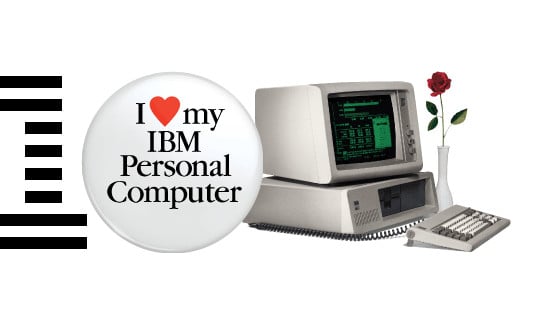
But the PC had one or two things going for it. Offices and departments could buy their own PC or clone, and start using a database or spreadsheet much more quickly, easily and cheaply. The alternative, of course, was to lease time from the company mini or mainframe, and go through the bureaucratic process of requesting that a software application be written or amended. As far as PCs went, there was choice of hardware, with multiple vendors selling "compatibles", or clones, and thriving dealer channels and training and support companies. The PC meant Novell for networks; SCO’s Unix (or one of dozens of now-forgotten species) for vertical back-office business applications; and for everything else, the biggest companies of the day - Lotus Corporation and Ashton Tate. The ubiquitous PC business applications – dBase, Lotus 1-2-3 and WordStar and WordPerfect - had their own "ecosystems". Trained users in the "ecosystems" provided a pool of skilled labour, macros and add-ins, and even serious, compatible products that produced charts or reports.
You may notice a couple of things missing. The idea of an "API" was unknown. The idea of a platform "ecosystem" - a multi-sided market - was unknown, because the "platforms" in the PC world back then were the applications themselves. DOS provided no API, merely interrupt vectors, invitations to cause trouble. On DOS, there was nothing out of the box to help you if you were an application developer. So if you had a new DOS software application, you needed to support all the peripherals yourself. If your customer had an HP LaserJet, or a swanky Hercules graphics card, you’d need to write the drivers; each application provided its own set. by 1989, WordPerfect had supplanted WordStar as the most popular PC word processor, partly because of its excellent driver support.
The "operating system" DOS was a misnomer: it was a boot loader. DOS had a crude 8+3 file system. There was no API to speak of - apps wrote anywhere and everywhere they could. And it was single-tasking, with task-switching possible only through crude third-party hacks.
So by the mid-1980s, IBM had two challenges. One was to fend off Unix and the Open Systems bandwagon and reclaim the PC for business and wind it back into the mothership. The second was to bring the PC into the modern era, which meant giving it multitasking, networking support, and the graphical user interface that almost every other system enjoyed. It did so in three ways – with a new software platform, a new hardware architecture, and a new TLA (Three Letter Acronym). With the hardware, the PS/2 range, IBM made the system bus proprietary in the hopes of licensing it to clones and add-in card vendors. Nobody wanted to know, however. Rather than making the rest of the world "incompatible" with IBM and therefore unattractive to punters, PS/2 merely made Big Blue’s systems incompatible with the rest of the world. Only IBM shops bought PS/2s, and IBM eventually relented.
The TLA was a grand all-encompassing bullshit strategy called Systems Application Architecture, and it was IBM’s very IBM-ish response to Open Systems. SAA promised huge sets of standards unifying IBM’s developer interfaces, user interfaces and communications protocols. For Big Blue, a rationalisation strategy was long overdue. For example, IBM systems didn’t use the industry standard character encoding system, ASCII – they used their own, called EBCDIC – and there were (at least) six versions of EBCDIC. SAA didn’t make IBM an "open system" at all.
The new PC operating system

The third strand of the IBM offensive was its new PC operating system, OS/2. This presented a new challenge for the company. For years, software was simply part of "the computer" that a customer bought, and only following Justice Department action in 1968 did IBM offer software unbundled from the hardware, in June the following year. Most big iron software continued to be written for, and tied to, the host hardware. IBM had never had to sell system software into a mature open market before, a market in which customers could make their own system software decisions. These were entirely new waters for Big Blue, and in those waters lurked something very aggressive indeed.
With its multitasking, fine-grained multithreading, IPC goodies like pipes and queues, a GUI and a new file system, OS/2 was a match for anything on the market. The kernel was extremely well-designed, and capable of multi-tasking everything thrown at it, and running apparently indefinitely. The OS/2 APIs also reflected the planning and foresight intended of a system which was meant to be used for many years ahead.
IBM had partnered with the relatively tiny outfit Microsoft to produce OS/2, and despite nearly axing the partnership, somehow the two staggered on to launch day. Here’s Bill Gates demonstrating Microsoft OS/2 in a 1987 corporate video:
So OS/2 was truly a new "platform". But it was brand new, and had no applications at launch. OS/2 needed an "ecosystem", as we call them today. What, then, to do?
What’s a platform?
IBM at the time had no idea of the concept of a hardware-independent platform. Quite literally, it didn’t know what it didn’t know. But then why would it have to? Customers generally bought what IBM told them to buy, the only question being whether they would buy the products sooner rather than later. OS/2 needed a market of developers, and widespread buy-in from hardware manufacturers, so that OS/2 could drive a wide range of graphics cards, printers and other peripherals. This was the classic chicken-and-egg problem. Why devote resources to a market that isn’t there?
For all the technical wizardry of the system, OS/2 applications offered few advantages of their own, and adopting OS/2 gave enterprise support teams a lot of new headaches.
IBM’s size and sheer industry authority compelled a few big DOS app vendors to make the switch: Ashton Tate produced dBASE for example, but the presence of the apps on OS/2 didn’t transport the ecosystems across. On the hardware side, device drivers were fiendishly difficult to produce, and three years after launch it was hard to get OS/2 to print. Today, platform vendors know they need to seed and cajole and even bribe these markets into existence – paying developers or device driver writers. Microsoft knew this, but IBM didn’t.
When it came to backward compatibility, OS/2 didn’t have a great story. Designed at first to be 16-bit, the new system didn’t take advantage of the useful features of the Intel 32-bit chip 80386, which allowed virtual DOS machines to run well. The ‘DOS Compatibility Box’ in 16-bit OS/2 was unreliable and slow. And so the only advantage of running OS/2 - in the absence of uniquely attractive apps or hardware support - was allowing applications to use more than 640kb of memory. As it happened, the summer of 1988 saw another surge in DRAM pricing, putting the 2MB needed to run OS/2 into the realm of the painfully expensive. Nor was the GUI particularly compelling. OS/2 with the Presentation Manager GUI put the new platform beyond the reach of even more legacy PCs.
Soon it was making more sense for a business to patch its DOS PCs with Heath Robinson task-switchers and memory extenders, at least for now.
The first version of OS/2 that staggered into existence at the end of 1987 was a limited, if rock-solid character mode interface, with built-in task switching. It would be a full year before the "real" graphical version of OS/2 with Presentation Manager arrived. It didn’t even have the modern file system, HFS, with hot-fixes and large file and partition support, that had been promised.
OS/2 bombed.
Ideas above your workstation
One development in the summer of 1988 would fundamentally change the relationship. DOS had had a memory barrier of 640kb, and there was a thriving market of DOS extenders, which both juggled memory blocks around and tricked the processor into lending the system a little more. OS/2’s undoubted selling point was its memory handling, with no restriction for applications all the way up to 15MB. But an intern at Redmond that summer had found a way of tricking DOS into running in the Intel 286’s Protected mode, giving it more memory.
The intern’s boss showed the work to Steve Ballmer, and Microsoft executives began to wonder if Microsoft could use the Windows shell to act as a DOS extender too. The PC could boot into DOS, start Windows, and gradually replace the DOS components underneath it, much like a driver making a wheel change while the car was moving. It would be tricky. But getting Windows to run at all was full of such hacks – it was, technically speaking, already self-modifiying code.
The "shell plus DOS extender" would not have the rich APIs of OS/2 – and the system would never ever be stable. It wouldn’t even give the user long filenames. DOS used the archaic 8+3 (“LTTR2BOB.WPD”) common a decade before. It wasn’t an operating system at all. But it was a GUI and with a bit of smoke, a few mirrors and a lot of faith on the part of the consumer, it could be presented as a new operating system.
And perhaps even at a stretch Windows could be marketed as a new "platform". The new platform meant all your existing applications were passé, but shiny new, more exciting ones would soon come along. No DOS GUI shell had a critical advantage at the time. It was potentially a winner.
Microsoft had several great advantages. One was that it was well-placed to coax an "ecosystem" into life: it had developer tools, it could price them cheaply, and it knew how to market Windows as "a new era", something with ever increasing momentum. Microsoft didn’t have legacy internal divisions to placate.
Secondly, it had a tremendous advantage in its relationship with PC builders. The PC builders, the OEMs, paid for Microsoft MS-DOS whether they shipped it or not. All customers wanted was something that ran dBase and 1-2-3. Microsoft could easily slip Windows onto every hard disk that shipped too, if it needed to. And trying out Windows was fairly painless and non-disruptive.
Thirdly, the press and pundits largely wanted Microsoft to succeed, and IBM to fail. This wasn’t through any great affection for Microsoft at all. But the clones had created a thriving market and nobody wanted IBM to control both the hardware and the software industry again. There was a strong desire not to return to a world controlled by one huge vertically integrated giant. This wasn’t apparent when Windows 3.0, the first version to do the Protected Mode trick, made its official debut in the summer of 1990, three years after OS/2 had been announced. Much of the press described Windows 3.0 as just another contender, vying with the GEM DOS shell, and Quarterdeck memory extender, for the DOS business.
But Microsoft had one more trump card to play.
Divorce
Microsoft had been hawking Windows 3.0 for many months before its summer 1990 launch, and everyone in the industry, it seemed, had a copy. It was clear that Microsoft saw Windows as more than a flower on the grave of DOS, a valedictory to the pre-OS/2 world we were all leaving behind. Far from it. Microsoft had done a lot of work to make Windows attractive, and was hyperactively promoting Windows to developers. It was a "quasi-platform", not a new OS at all, but it was one that finally allowed developers to run a GUI. And developers who were fed up with poor sales of OS/2 products were responding positively. At the same time, Microsoft was obliged to continue to show demos of the 32bit OS/2 to the press, and these were everything that the 16-bit version was not.
Microsoft’s mutant "quasi-platform" Windows 3.0 was launched with a splash and started to sell well. It was now evident that all the way through 1989, at least some of the developers who had swotted up for OS/2 Presentation Manager had - in the absence of any action - turned their talents to Windows. Windows had provided them with plenty of opportunities and appeared to have a glimmer of a chance of a market, albeit perhaps a temporary and modest one. But something was better than nothing. Soon there was a increasing supply of attractive new Windows applications followed by a stampede of acquisitions as the major application vendors looked to plug up a hole in their portfolios. In just one month, Microsoft had sold more copies of Windows than IBM had shifted copies of OS/2 in two years.
IBM tried to persuade Microsoft to give up on Windows on several occasions in 1988 and 1989, but Gates refused. It wouldn’t go away. Then, unknowingly, IBM’s PC boss Jim Cannavino made a catastrophic error. Aware of Microsoft’s growing enthusiasm for Windows, he was unwilling to concede an inch and give it any credibility – but couldn’t bring himself to rip up the agreement with Microsoft either. He ended up giving Windows a tepid endorsement - a vital blessing - and breathing space. Windows was positioned as a kind of "training wheels" for OS/2, even though the APIs weren’t compatible. IBM had many opportunities to fire Microsoft, and ditch OS/2 – but this would be the single most disastrous error it made.
That was in September 1989. IBM's second most catastrophic error was not ripping up the joint development agreement - and dumping and/or outflanking Microsoft. Relations disintegrated as Windows sold in huge numbers.
Suddenly, the ecosystem advantage enjoyed by Ashton Tate and Lotus began to evaporate overnight. Windows provided the device drivers. The new skills base would need to know how to use Windows. Eccentric keystroke sequences were no longer an advantage. WordPerfect tried awkwardly to bridge the divide, retaining old DOS keystrokes for its first Windows version of the software, but it was not successful.
March on the enterprise
In business, Windows PCs began to be used for running Noddy forms based front end applications. Microsoft launched Visual Basic in May 1991 – a crude, graphical scripting language – but one that was able to call routines in compiled libraries. Windows also gave Microsoft’s application division a huge boost. Microsoft's Multiplan and Word had a respectable but tiny market share in the DOS world. Its Windows counterparts, Excel and Word 2.0, were much stronger. Microsoft also began to bundle in its office applications, with Access database and office Mail software, undercutting the established rivals significantly. It was possible to pick up "Office for Windows" for little more than the price of dBase or Lotus 1-2-3.
For almost two years the battle between IBM and Microsoft became a PR war of attrition. IBM had failed to kill Windows or walk away from Microsoft. The inevitable divorce took place in April 1991. The contractual settlement saw IBM take sole responsibility for developing 32bit OS/2, and bundle a licence to bundle Microsoft's Windows code with the product. Microsoft canned its own 16bit development of OS/2 almost immediately, although it would continue to sell "Microsoft OS/2 LAN Manager" for a few more years – the name OS/2 was written progressively smaller on the box.
Author Paul Carroll relates in his Big Blues: The Unmaking of IBM that by the time the divorce was public, Microsoft had sold 13 million copies of Windows 3.0 in under a year, and IBM had moved just 600,000 copies of OS/2 in over three years - of which 300,000 were "real" sales - far fewer were actually in use. On the back of Windows sales, and the demand for Microsoft Windows-based applications, Microsoft had grown from a small company of 1,800 staffers to an organisation with 10,000 employees.
Yet even then, the odds were against Microsoft. As Gates later described it:
It was only when they broke off communication and decided to go their own way that we thought: 'Okay, we're on our own, and that was definitely very, very scary'.
What made it even scarier was that the 32bit version of OS/2 was everything that the 16bit wasn’t. It was a quite stunning system. It just wasn’t ready yet...
The Empire Strikes Back
The new 32bit OS/2 took advantage of several features of Intel’s 386 processor: a flat memory model and the ability to virtualise DOS sessions, yet maintain process communications between them. The 32bit version also supported the whacky DOS memory extenders, gave DOS applications fast 32bit disk I/O without them realising it, and once in a crash-proof OS/2 virtual session, the DOS application ran better than before. Both IBM and Microsoft were justifiably proud of this. IBM took Microsoft’s Flight Simulator – one of the most demanding graphical DOS games – and started one instance after another, until a dozen were running concurrently. All just kept ticking along.
All of a sudden, OS/2 looked a far, far superior product that answered many of the problems DOS had caused business customers for years. It even ran Windows programs faster than DOS could, and in multiple virtualised sessions. So OS/2 offered the the best of all possible worlds: old DOS apps with their skills base and third party add-ons, the newer wave of graphical Windows apps, plus native OS/2 apps.
There were delays, however. IBM had decided to add spruce up OS/2 with a radical new shell, called the Workplace Shell. It was more than just a UI chrome, but a set of object-oriented class libraries which could be overridden or extended by a developer. The Workplace Shell allowed OS/2 to do some of the tricks of the Mac, and plenty more of its own. It also gave it a radical feel that still startles to this day (see the Box out on page 5: WPS – WTF?!?). Bizarrely, OS/2 was gathering an evangelical grassroots support, thanks in no small part to the extraordinary demonstrations of IBM’s David Barnes, one of the industry’s great demo-gods. Here’s Barnes in full flow in 1993:
Microsoft needed a story, so it cast around and found one. This was a new multi-user portable operating system still in the very early stages of development, and it would prove decisive. It was called OS/2 version 3.0, or OS/2 NT - and it would be the most powerful piece of vapourware ever created. In 1990 this barely consisted of more than a bootable kernel; it would be three years before anyone could buy it, and six before it gained any traction. But it changed perceptions significantly.
RISCy business and the Unix-killer
The fact that this new OS was portable to different chip architectures was seen as very important. The conventional wisdom was that Intel’s processor architecture had run out of steam, and RISC chips were the future. New RISC processors from MIPS and Sun (Sparc) led the workstation field, with even late-comers like DEC (Alpha) and IBM (Power) obliged to follow suit. It would be hard to pick a winner.
Yet the new vapour platform also promised to deliver something that the warring Unix vendors should have, but didn’t: a unifying platform, with rich APIs. The Unix vendors perpetuated a tyranny of small differences. They fought bitter wars over tiny details irrelevant to most users. They plotted and schemed, partnered and divorced, ditching much of the most attractive work (like Sun’s NeWS Display Postscript UI) in a futile effort at compromise.
Unix should have been a player, but IBM joined the everyone-except-Sun alliance called OSF instead. It left a vacuum that Microsoft’s opportunistic marketing exploited. NT was a vapourware product, but Microsoft promised to help port it: creating MIPS, Alpha, even IBM/Motorola RISC chip PowerPC versions. NT promised to run 16bit OS/2 binaries and POSIX UNIX binaries. And Microsoft promised a unified API, "Win32", so code would run on DOS-based Windows and NT. By the time the warring Unix factions woke up to the threat and signed up to a common "Spec 1170" in 1993, nobody cared.
So the vapour platform allowed Microsoft to create a pincer movement. Microsoft told customers to wait for the 32bit version of Windows, Chicago, which would ship in 1993. This would be DOS-based but would offer many of the advantages of OS/2, such as long file names – and would run in 4MB. And they should start preparing for the Unix-killer, Windows NT. Not only was NT a Unix-killer, but it would morph into an all-singing, all-dancing object-oriented system called Cairo.
There were promises as far as the eye could see, right to the end of the Yellow Brick Road. IBM realised it had one last chance to regain the market, and recoup some of the billions of dollars it had spent on the OS/2 project. In Autumn 1994, a much-optimised OS/2 version 3.0 - Warp - was launched with heavy TV advertising, unusual for IBM. It came in two packs, one which included Windows, and one which took advantage of the Windows already installed on a hard disk. IBM was much smarter than Microsoft in realising the potential of the web: it was the first OS to include a web browser. Microsoft, meanwhile, was busily building an ambitious walled garden system, a "Compuserve-killer" to include in Chicago, and didn’t even include a TCP/IP stack in Windows.
OS/2 briefly caught the imagination of a small set of consumers, but it was far from being a turnkey consumer product - which it had to be, since the only major PC OEM who dared pre-install OS/2 was IBM’s own PC division. IBM’s support teams weren’t used to dealing with non-technical users. New OS/2 users were greeted with a laborious installation process, iffy device support, and a lack of native applications. OS/2 ran DOS and Windows so successfully, and had few compelling major applications of its own: so the big independent software vendors focused on the more lucrative Windows market.
As it turned out, Chicago didn’t ship until August 1995, and Windows 95 - as it was officially called - didn’t run in 4MB. NT was too big and slow for the market, and lacked office applications – the promise of portability of the Win32 didn’t really materialise. Windows NT didn’t take off until a year later, when customers demanded a version of the Windows 95 shell. By then, architectural changes removed much of NT’s USP. Microsoft had introduced arbitrary network connection limits on the workstation (which could until then function as a pretty robust departmental server) and moved graphics device drivers into kernel space, sacrificing stability for speed. Cairo was quietly abandoned.
One more shot at glory
In the late summer of 1995, IBM threw in the towel and redeployed most of its programmers. It would release one more version of OS/2 in 1996, bundling voice recognition and giving it a more familiar UI, and Big Blue would continue to support it for many years. But it was over – Microsoft had won. What convinced IBM CEO Lou Gerstner of the futility of continuing the project was the dearth of native OS/2 applications. IBM had also let him down. Its nebulous "Workplace OS" strategy involved OS personalities running on a microkernel – but failed to enthuse customers and failed to deliver. Around 2,000 developers had been working on a portable version of OS/2, primarily to run on IBM’s RISC workstations, but it wouldn’t work reliably. The Taligent object-oriented OS came to nothing. And IBM failed to acquire Apple. Microsoft’s Win32 pincer strategy had captured the market.
WPS – WTF?!?
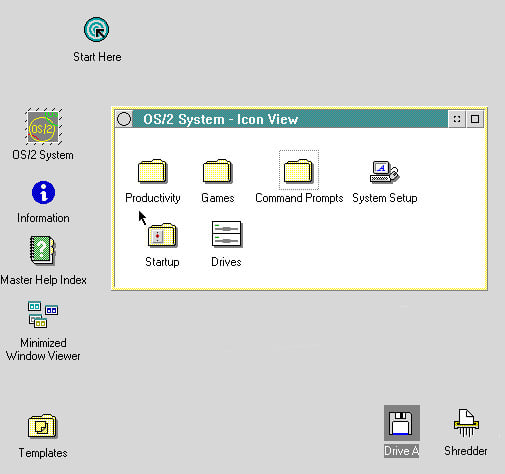
Workplace Shell first appeared in OS/2 version 2.0, released in April 1992 - the same month as Windows 3.1.
It came from IBM's plans for the "office of the future" - the design labs producing a very literal object-oriented functionalism - as mocked up in this print advertisement from 1990, which predates the WPS:
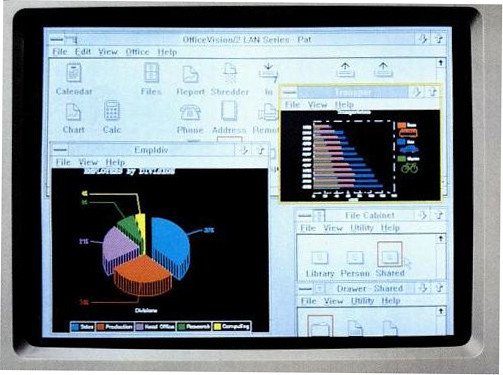
OfficeVision: IBM print ad 1990. The product never shipped.
It was hard to sell this office automation to consumers, so IBM argued that it was more flexible. Here's a TV ad:
It had so much flexibility you could change the font and wallpaper of every window element and every window individually. The WPS had more useful features, though. Like the Mac, shadows (or aliases) would follow the original around. Template folders could contain apps and documents and be cloned quickly. Closing the folder minimised all the apps and documents associated with it. It had other eccentricities. By default, icons couldn't be moved with the main mouse button, although that was easy to change.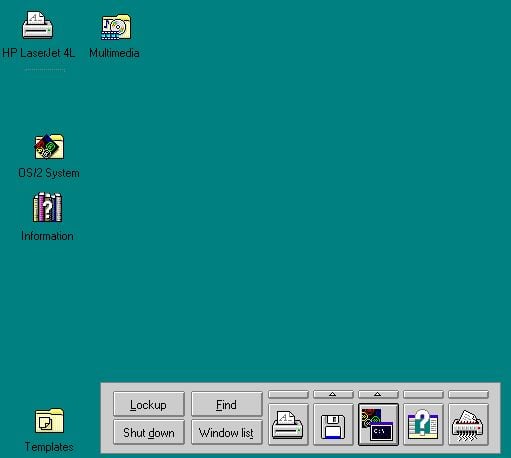
OS/2 Warp 3.0
For the consumer push in autumn 1994, OS/2 gained a hurriedly written floating dock
The final version of OS/2 included much more familiar-looking elements. A system menu gave one-click access to every file on the PC, and original Mac icon designer Susan Kare gave it a makeover. Kare had designed the icons for Windows 3.0.
For some reason, IBM gave every mouse action (for example, every drag) a deafening sound.
Why did IBM lose?
Microsoft’s ascent to the top of the PC industry continued to cause great passions. If you had said, in 1987, that Intel and Microsoft would in a decade define the industry, most would have laughed. Intel was struggling to produce competitive RISC chips, and Microsoft had never written an operating system. But the answers to the questions: "Why did Microsoft win" and "Why did IBM lose" are really different.
IBM had never met a competitor like Bill Gates before – one quite so ruthless and opportunistic. Gates fought hard and IBM couldn’t shake him off. But with or without OS/2, IBM could have outflanked him or even dispensed with the nuisance altogether, if it had developed a coherent strategy, one giving customers reasons to think positively about spending money with IBM.
IBM should have realised earlier that the path to OS/2 was a radical one for customers in 1988. It could have taken control of DOS and enhanced it, to offer a smoother upgrade path to the GUI world. In fact, this is what IBM belatedly did – with a product dubbed PM for DOS – which never made it to market. But it was too late. IBM could have made an expensive acquisition of Apple, the most attractive consumer UI, and put it on a firm technology base. But even Apple failed to do this. And even more radically, Big Blue could have realised where the value is in software and competed higher up - helping to create a Linux-like platform that was free.
There are plenty of narratives in this particular counter-history – but most require quite a leap of imagination. It’s hard to see how once Microsoft was established, and had captured the mindshare of developers, the great "unifying platform" of OS/2 could win them back. It’s more useful to look at why Microsoft won.
Firstly, Microsoft ruthlessly went after the market and didn’t care about being liked, or being right – just about driving lots of copies of Windows into the market. The market didn’t like Microsoft, but Microsoft made them money. Software vendors, hardware vendors, peripheral makers – they all made more money with Windows. The software insulted you daily, but the "ecosystem" looked a lot healthier. IBM had no idea of what it took to build a new ecosystem. The suits thought that if they'd built it, and it was good (it was, eventually), then the customers would come – because of the magic letters IBM. The IBM sales teams had acquired many dark skills, including leveraging other IBM products and services. These were no use in a knife fight, on an open plain, with Bill Gates.
Microsoft was also in this 100 per cent. It was not compromised by having to placate a warring division. Gates was not content to settle, as others may have been, for writing applications and tools for other people’s platforms. He wanted the platform. Microsoft had to make Windows work pretty well. There’s no denying that Microsoft had a huge advantage in its ruthless licensing arrangements. PC makers had to pay Microsoft for DOS whether they shipped the PC with DOS or not – so where was the incentive to bundle an alternative? Microsoft eventually lost an antitrust action and made substantial settlements in civil suits with Novell, Be and Sun. But remember, it takes two to tango. Some blame must fall on the short-sightedness of the OEMs and the channel.
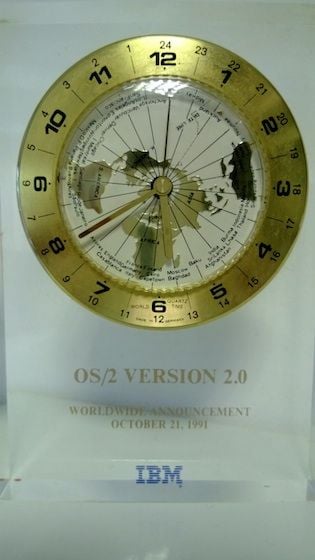
This beautiful timepiece celebrated the global
announcement of OS/2 version 2.0 in October 1991
The OEMs didn’t cry foul at Microsoft’s licensing policy, and this came back to bite them. As the furious competition of the OS wars subsided, Microsoft increased its prices – which is one of the perks of being a monopoly. And as hardware prices fell, the proportion of the ASP going to Microsoft increased. OEMs which had once made handsome margins were squeezed. Nor could they differentiate themselves from each other, Microsoft didn’t allow it – it compromised the ‘Windows experience’. Sometimes it benefits a business to sacrifice margin today in order to keep competition alive and preserve margins in the future. Many actively do this – but the PC hardware industry didn’t.
In the recriminations that followed the OS wars, OS/2 devotees would complain that the computer press was almost uniformly hostile to OS/2. They were quite right – you could count the number of journalists who used and liked OS/2 on the fingers of one hand. (One was John Lettice, founder of The Register - and another was your reporter. The charming OS/2 2.0 souvenir pictured above sits at Reg HQ today). But the press were reflecting both sentiments and economic choices that were widespread. They didn’t want to go back to a world where IBM defined the standards for the open PC.
They were so busy fighting the last war that they didn't see the next one coming. Writing in 1995, as the OS wars raged on Usenet (though it was already clear who had won), the late Guy Kewney summed up his exasperation:
My friends tell me Microsoft will save us from IBM. But who will save us from Microsoft?
®
